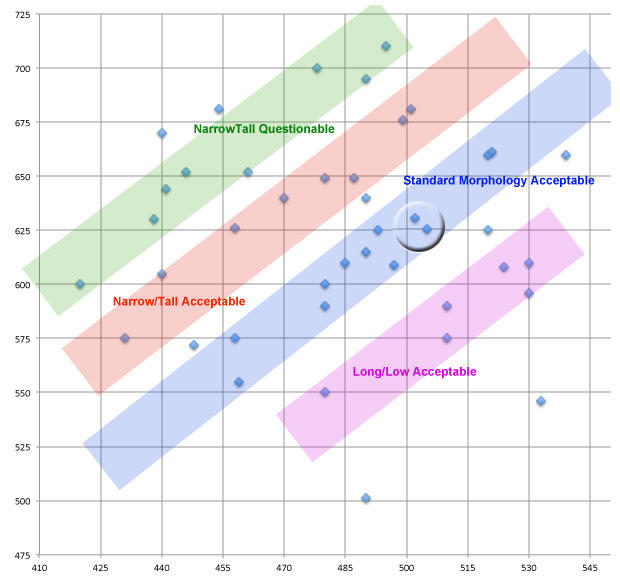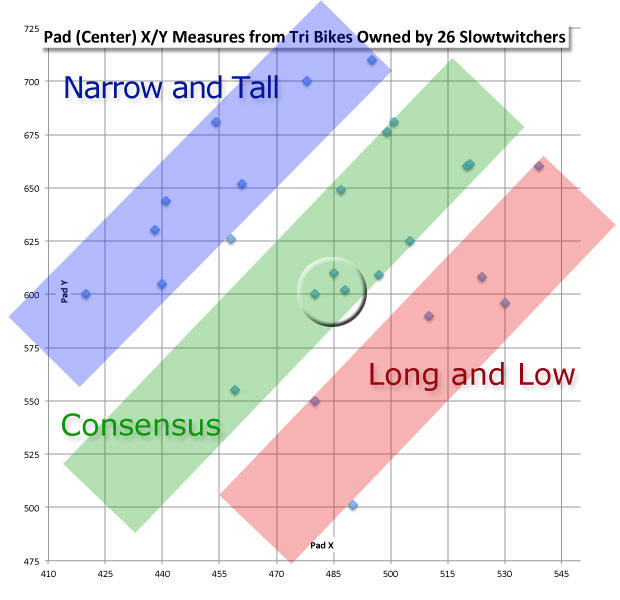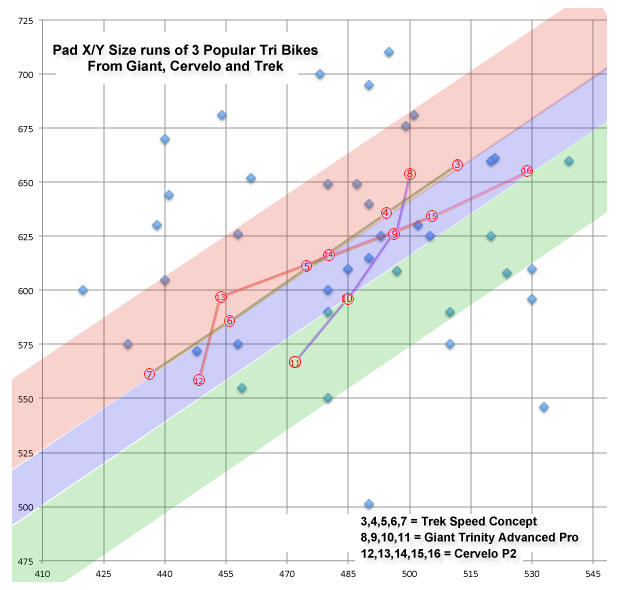A Bike for Davos
I’m on a mission to prescribe. The last time I went on a prescribing rampage was about 15 years ago. I’m doing pretty much the same thing just with better, modern metrics and calculators that give bike fitters the ability to prescribe a complete bike with much greater accuracy and detail.
This requires fabricating fictionalized stereotypes. I’m not prescribing a bike for YOU. I’m prescribing a bike for someone very much like you, and after I present all my stereotypes hopefully you find yourself in there.
These stereotypes are generated by comparing morphology, fitness and riding style. You might have long legs or short, you might be lean or be carrying an extra 30 pounds. You might ride steep or less so. By the time I'm done I'll have prescribed for just about everyone.
For this exercise the metrics on which I’m focusing are Pad Y and X, that is, the rise and run, in millimeters, from the bottom bracket up to the height of your aerobar pads, and then out to the center of those pads. This aren't the only metrics that can be used to prescribe a bike, but using Pad Y and X allows me to back into the prescriptions for all kinds of tri bikes, super and mortal.

Each stereotype needs a name. I’ve decided to bestow each the name of a character in the HBO series Game of Thrones. Last week my first analysis was on Ramsay, who in real life is played by a trim and fit (to look at him at least) actor who is 5’8” tall. Someone like this, who is 5’7” to 5’9”, average in morphology, riding pretty aggressive, last week’s article prescribed some bikes that would fit him.
(Spoiler alert: Ramsay, alas, is no longer with us, as followers of Game of Thrones know. For Throners, you might find timely a hot thread on our Reader Forum: Preventing Dog Attacks On The Bike.)
Davos Seaworth is played by Liam Cunningham, a 55 years old, 6’1” tall Irish actor. Like Ramsey, Davos is fit and trim but he’s 55 of course. He’s not going in for any of that long and low stuff, but I'm holding up the banner for us oldsters and I see no reason why he can’t ride as do certain pro triathletes, the difference between pros and age groupers (up to those in their 50s) being the engine more than the chassis. I do not believe that trim and fit age group racers cannot ride the positions pros ride. (It’s pros who cannot ride the positions that many age groupers ride!)
Inside the circle in the chart above we find the Pad Y and X of two Slowtwitchers, user names BrickMick and Sp1ke. Their actual Pad Y measure is between 625mm and 635mm and Pad X is between 500mm and 510mm. This is a very typical position for somebody between 6’0” and 6’3” who rides pretty steep, with a fair bit of armrest elevation drop from the saddle (13cm to 17cm depending on saddle height).
Let’s split the difference in that range and our stereotype (Davos) will have a Pad Y/X of 630mm/505mm.
What’s below is not a complete list. I’m going to pencil out a few options so that you get the hang of how this process works and, by the way, while all modern dynamic fit systems work basically this way, this is the system built, brick by brick, by F.I.S.T. over the past 15 years.
Trek Speed Concept: This is a great solution for Davos (and for Slowtwitchers Sp1ke and BrickMick). What fits Pad Y/X of 630mm/505mm is a Size-L frame, with a low-far stem and a 35mm pedestal. There’s a 5mm spacer that goes between the mono-extension and the wing on which the armrests sit, and adding that spacer makes the Pad Y exactly 630mm. The very center of the Pad X range for this bike and stem is 495mm, so you’d push everything out about 10mm to get your 505mm Pad X. You have options. The mono-extension has 4 sets of holes, so there is no center (if there were 3 holesets, or 5, there would be a center.). So choose the holeset that gives you a slightly longer (than center) position and you’re dialed. Trek makes this so easy.
Felt IAx: There are 2 answers to this question. The carbon aerobar option, on the more expensive IAx (IA 10, 14, 16) sits about 10mm lower than the aluminum option. If you get the aluminum version, the 56cm will fit you pretty well. But, the bar is slammed in this case. If you want to go lower, no place to go without changing aerobar or stem pitch. You’ll need to push the pads out about 17mm to get your 505mm. There are 3 holesets in the Felt armrests. You use 2 of these 3, so, instead of using the 2 holesets that push the pads slightly rearward, use the 2 that push them slightly forward. That gives you 15mm of the 17mm you need of forward cockpit push. If you choose a Felt IA 10, that will come with the carbon aerobars, which are slightly lower, so you’ll place a 10mm pedestal in there. You could go to a 54cm, but that’s not got a long enough wheelbase.
Cervelo P5 : What would you ride in a P5? You could ride either a 54, 56 or 58 based on their fit matrix. But the bikes wouldn’t be equal in handling. The 54 would ride like a unicycle. Riding the 61cm would be like a tractor-trailer. So you’re a 56 or a 58. You’ll ride the 56 with the low (not hi-V) stem and with 30mm of pedestals under the stem. The 58 would the same stem config but only 10mm of pedestals. The cockpit range for the 56 is a Pad X of 473mm to 523mm, so the center of that range is 498mm (7mm less than what we’re looking for). On the 58cm I’d need to pull the bars back 17mm from the center of its cockpit range. The bike’s slightly longish. It’s got 640mm of front/center versus the 622mm on the 56cm size. In other words, you're not a 56cm or a 58cm in this bike. You're a 57cm, but they don't make one. It’s a coin flip, but the 56cm might be very slightly better because it’s cockpit-center is closer to the Pad X we’re looking for.
Orbea Ordu LTD series: I like this bike a lot. Besides the fact that Starky beats on everybody’s legs with a baseball bat every time he hikes his leg over the top tube of his Ordu, this frameset at $3,299 (frame fork, seat post, headset, and TriRig brakes front and rear) is a muscle bike ready to be built. It looks like a superbike but you can put any stem on it. And any bar, if you buy it as a frameset. But let’s consider how it comes stock, with a -6° 90mm stem and a Vision TriMax bar. I use my HX/HY calculator for this, but simply put this bike in size L, with the pads in the rearward (of 3 available) holeset, and 25mm of pedestal under the (low pad profile) aerobar pads, gets you to within 2mm of 630mm/505mm of Pad Y/X if you swap the 90mm stem out for an 80mm steam. I’ll write more about this bike when we come to some long/low prescriptions.
Giant Trinity Advanced Pro: I know what you’re thinking. I’m a Size-L in just about everything else (except a Dimond), so I’m a large in this. No. You’re a Size-M. The Pad Y range is very clearly 610mm to 630mm according to the size matrix Giant produces. The bike is about 10mm tight, everywhere, above and below the waist of the bike, in the cockpit and in the front/center. You can ride this bike fine, but it’s really built for taller versus longer positions as the bike ascends in the size range. Last week I wrote about how this bike begins, in its small sizes, as a kind of long/low bike but ends up more like a narrow/tall bike as the sizes get larger through the size run.
Cannondale Slice: Just the way it’s spec’d from the factory in 57cm, Just with a 100mm stem, -6° pitch, 20mm of total headset top cap + spacers.
You can also ride a BMC TM01 and TM02 successfully with a 630mm/505mm Pad Y/X position. You can ride a Dimond, a Cervelo P2 or P3. With this particular position it is low enough that it becomes tougher to ride with taller frame geometries, like Felt’s B series, the Specialized Shiv, and the Scott Plasma. These are fine bikes, but not so much with a Pad Y/X of 630mm/505mm.




Start the discussion at slowtwitch.northend.network